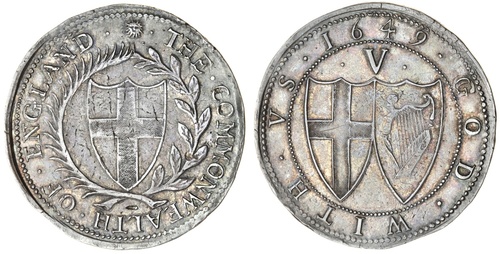
Auction: 19021 - The Dr. Erik Miller Collection Part I - Crowns
Lot: 20
Commonwealth (1649-1660), Crown, 1649, m.m. sun,
Hepburn-Wright, collection dispersed by Spink (acquired June 1964) - "very large flan, R5, nearly extremely fine" - £350.0.0
Thorpe, second collection, Spink Numismatic Circular, March and April 1952 (this coin not listed)
Lt-Col. Morrieson, 20-24 November 1933, lot 685 - extremely fine and very rare - £44.0.0 (Seaby)
Bliss, 15-19 May 1916, lot 474A - very fine and an extremely rare date - £17.10.0 (Spink)
Moon, 7-10 May 1901, lot 261 - extremely fine and excessively rare, very few specimens known - £15.10.0 (Verity)
Duchess of Beaufort {"Nobleman"}, 1-2 May 1890, lot 39 - "fine and round; and a scarce date" - £19.0.0 (Verity)
An account of prices realised for the Beaufort sale was published in the Western Morning News on 5 May 1890, including mention of the coin presently offered. Transcribed here, it is remarkably reminiscent of auction results of the recent past:
"During last week the rooms of Messrs. Christie, Manson and Woods, in St. James's-square, were thronged with numismatists and collectors from all parts of the kingdom at the dispersal, under the hammer, of a very valuable collection of coins, the property of a celebrated nobleman. The coins when placed in Messrs. Christie's possession had evidently been uncared for, for a considerable number of years, and were by no means in the order in which such rarities are nowadays accustomed to be retained by their fortunate owners. This is, perhaps, another instance of how often valuable antiquities and unique works of art are buried in the cabinets of unused and remote country mansions or lost for long periods in the possession of ducal families. The most recent sale has again testified to the enormous, almost incredible, appreciation in the value of the rarest examples of the English series of coins and of what are known as "pedigree" coins - that is where the possession is clearly traced through numerous collections from date of striking. Thus, as was stated in these columns at the dispersal of Mr [Egmont-]Bieber's collection in [1889], it is nothing uncommon for specimens of the rarest issues to make eight, ten, and even more times as much as was thought to be their value under a dozen years ago. Amongst others, for a Commonwealth Crown of 1649, but one other is known, £19 was realised. A Scarborough siege half-crown, temp. Chas. I, a rude, almost unshapen piece of silver, originally the plate of the Oxford Colleges, and having a view of Scarborough Castle and 11s. vid. impressed on the obverse, £49. This is the rarest of the siege series. A gold Charles I pattern Broad, crowned [£95], and a Charles II proof Crown in gold of 1663 no less than £252, the owner being offered £300 next day. Of course, each was in the finest condition. Holders of good collections of coins may be congratulated upon possessing property which is increasing in value by leaps and bounds, and as to which every occasion when dispersal of known collections takes place, emphasises the fact that the most celebrated pieces are being rapidly but certainly collated in a very few hands" [sic]
Subject to 20% VAT on Buyer’s Premium. For more information please view Terms and Conditions for Buyers.
Sold for
£28,000




